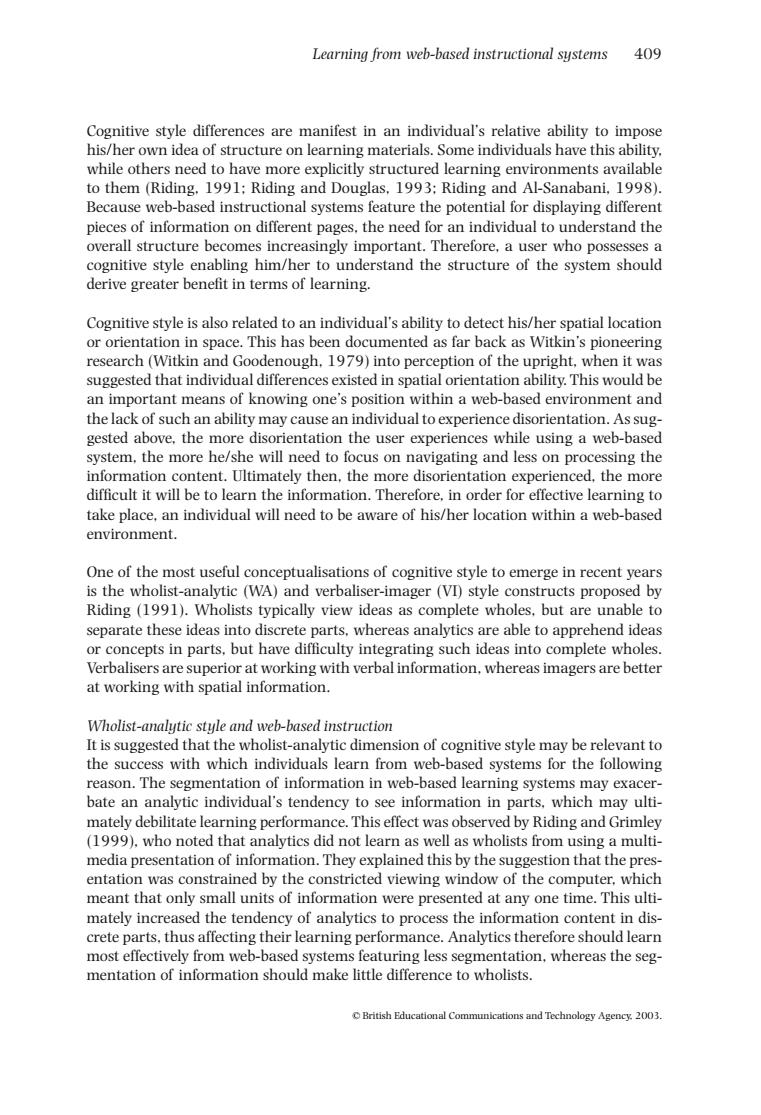正在加载图片...

Learning from web-based instructional systems 409 his her own ide a of structure on learning materials ome individuals have this ability while oth need to to them(Riding.1991:Riding and Douglas.1993:Riding a Al-Sanabani 1998 Because web-based instructional systems feature the potential for displaying different pieces of information on different pages.the need for an individual to understand the overall structure becomes increasingly important.Therefore.a user who possesses a cognitive style enabling him/her to understand the structure of the system should derive greater benefit in terms of learning. Cognitive style is also related to an individual's ability to detect his/her spatial location or orientation in space.This has been documented as far back as Witkin's pioneering research(Witkin and Goodenough.1979)into perception of the upright,when it was suggested that individual differences existed in spatial orientation ability.This would be an important means of knowing one's position within a web-based environment and the lack of such an ability may cause an individual to experience disorientation.As sug- gested above.the more disorientation the user experiences while using a web-based system.the more he/she will need to focus on navigating and less on processing the information content.Ultimately then.the more disorientation experienced.the more difficult it will be to learn the information.Therefore.in order for effective learning to take place,an individual will need to be aware of his/her location within a web-based environment One of the most useful conceptualisations of cognitive style to emerge in recent years is the wholist-analytic (WA)and verbaliser-imager (VD style constructs proposed by Riding (1991).Wholists typically view ideas as complete wholes.but are unable to separate these ideas into discrete parts.whereas analytics are able to apprehend ideas concepts in parts.but have dificulty nte ating s ch ideas into co plete wholes. erhalis s are superior at working with verbal information.whereas imager s are better at working with spatial information Wholist-nlrtieendwdnctio It io gge ested that the wholist-analytic dir the with which individuals learnfro The of infor ed lea nalytic individual's te see info n in nay ulti- tely debilita 999.who ing pe .This effe ding and G analytics did n d this byt IS W on the pre meant tha on nits o lorma n were preser mately incre tendency of analytics to proce inlormauo affecting their learning perlorn .Analyticst rom we mentation of information should stems ng less segm ation,whereas the seg- C British Educational Communications and Technology Agency 2003 Cognitive style differences are manifest in an individual’s relative ability to impose his/her own idea of structure on learning materials. Some individuals have this ability, while others need to have more explicitly structured learning environments available to them (Riding, 1991; Riding and Douglas, 1993; Riding and Al-Sanabani, 1998). Because web-based instructional systems feature the potential for displaying different pieces of information on different pages, the need for an individual to understand the overall structure becomes increasingly important. Therefore, a user who possesses a cognitive style enabling him/her to understand the structure of the system should derive greater benefit in terms of learning. Cognitive style is also related to an individual’s ability to detect his/her spatial location or orientation in space. This has been documented as far back as Witkin’s pioneering research (Witkin and Goodenough, 1979) into perception of the upright, when it was suggested that individual differences existed in spatial orientation ability. This would be an important means of knowing one’s position within a web-based environment and the lack of such an ability may cause an individual to experience disorientation. As suggested above, the more disorientation the user experiences while using a web-based system, the more he/she will need to focus on navigating and less on processing the information content. Ultimately then, the more disorientation experienced, the more difficult it will be to learn the information. Therefore, in order for effective learning to take place, an individual will need to be aware of his/her location within a web-based environment. One of the most useful conceptualisations of cognitive style to emerge in recent years is the wholist-analytic (WA) and verbaliser-imager (VI) style constructs proposed by Riding (1991). Wholists typically view ideas as complete wholes, but are unable to separate these ideas into discrete parts, whereas analytics are able to apprehend ideas or concepts in parts, but have difficulty integrating such ideas into complete wholes. Verbalisers are superior at working with verbal information, whereas imagers are better at working with spatial information. Wholist-analytic style and web-based instruction It is suggested that the wholist-analytic dimension of cognitive style may be relevant to the success with which individuals learn from web-based systems for the following reason. The segmentation of information in web-based learning systems may exacerbate an analytic individual’s tendency to see information in parts, which may ultimately debilitate learning performance. This effect was observed by Riding and Grimley (1999), who noted that analytics did not learn as well as wholists from using a multimedia presentation of information. They explained this by the suggestion that the presentation was constrained by the constricted viewing window of the computer, which meant that only small units of information were presented at any one time. This ultimately increased the tendency of analytics to process the information content in discrete parts, thus affecting their learning performance. Analytics therefore should learn most effectively from web-based systems featuring less segmentation, whereas the segmentation of information should make little difference to wholists. Learning from web-based instructional systems 409 © British Educational Communications and Technology Agency, 2003